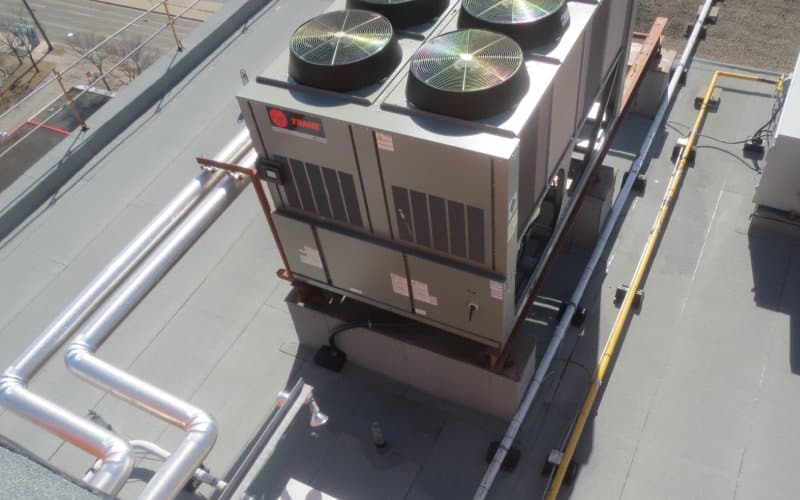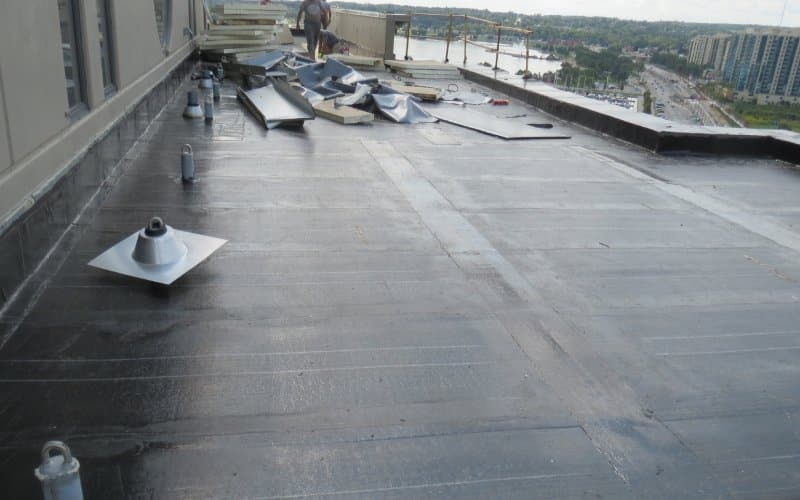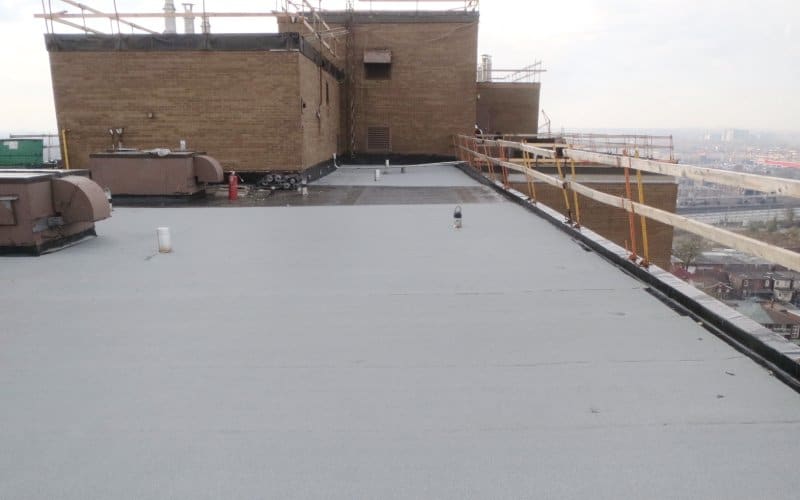500 Hood Road, Suite 320Markham ONL3R 9Z3

The extreme temperatures (and especially the extreme temperature fluctuations) and range of weather conditions is hard on existing commercial roofs, and makes it hard for installation of new roofs
Because of the flat roof style, commercial roofs are especially vulnerable to build-up of snow, water damage from blocked water, and other risks, and owners should be aware of these risks.
As a commercial building owner in Ontario, you need to understand how the different conditions affect commercial roofs, for informed decisions on maintenance and repairs. Ontario is a particularly challenging area for roofing because of the weather elements it faces. From harsh winters, to the rains and high winds of early spring and late fall, as well as the sun and heat of summer; your commercial roof needs to be able to withstand it all.

While every season has its challenges and puts stresses on a roof and roofing materials, the best roofing season for repairs or installation of a new roof is limited to the short period of summer. There may be times when repairs on commercial roofs need to be completed at different times, but it is not ideal. Heavy snow in winter, and rain and winds in the transitional seasons of spring and fall mean that you are looking at having to schedule work in a limited period of time. You need to plan ahead, knowing what work needs to be done, and scheduling that work in advance, before suitable contractors are all booked up.
It is important to ensure good choices for roofing materials are made for the installation of a new roof or for replacements. Materials should be designed to withstand the sun and heat, heavy snow, and more.
Regular inspections are critical to ensure preventive maintenance is done, and any damages are caught early for repair so larger repairs or even replacements aren't needed. Knowing the types of damages common throughout the different seasons guides the inspection process more effectively, and helps you be prepared. Also, damage to the roofing leads to related, secondary issues, such as HVAC units having to work harder and face undue wear and tear.

Hazardous weather conditions can cause the biggest damages to your roof, affecting its overall condition and performance. Ontario experiences different severe weather conditions year-round. Roofs are built to withstand general expected forces for the environment, but extreme conditions go beyond those expected conditions.
For example, a flat roof does have a very slight slope, and does shed water when it rains, but they are designed for normal rain and other average weather conditions. However, during heavy rains, the drainage system can't handle the quantity of water gotten in a short time.
Snowstorms and ice storms create weight buildup, as well as damages from debris tearing materials. Slush and snow can also shift or break roofing components. Ice dam formations, blockages to the drainage system, and other issues further complicate things.
Lightning in thunderstorms is a summertime risk, unless you have a lightning protection system. Heavy wind can pelt debris at your roof, tearing through the roofing membrane and flashing. Wind can find weak spots, too, and blow through ventilation units or other spaces, causing more damage. With heavy rains, flooding water can leak through and cause mold, mildew and other water damage. Hail causes impact damage and tears materials. Hail is heavier and harder than rain, so can cause significant damage.
Sun may seem like a respite from these issues, but UV exposure is damaging, causing cracking of roofing materials, especially during an extreme heatwave and extended period of intense sun. Modern materials are improved for UV resistance, but can still fail due to overexposure.

While severe weather causes dramatic issues, even ongoing, average weather causes wear and tear that building owners need to be aware of. In addition to the specific risks of each season, the multiple freeze and thaw cycles that a building faces, sometimes within the same month, is hard on roofing materials.
Early spring can feature several freeze-thaw cycles, and heavy, slushy snow or rain. Any leaks created by winter conditions can be aggravated, and new ones may develop too.
However, as conditions get milder, this is a good chance to get your roof inspected, to spot any winter damages, and to plan repair work for the summer.
Although the relatively easier weather conditions of summer make this the prime season for getting work done, it does still have its share of weather challenges that put wear and tear on your flat roof.
UV exposure and heat breaks down roofing materials and can degrade sealant materials. Ontario is known for high humidity along with high temperatures, which causes swelling and weakening of commercial roofing materials.
Having more people on the roof to perform work adds to the loads your flat roof faces in this season.
Fall brings dead leaves and branches that can collect on your commercial roof, blocking drainage and gutters, and causing mold and fungus. The branches can also tear or puncture roofing materials. Water can collect and cause leaks. Cold weather-related issues start to return. Freezing and thawing further breaks open any cracks or leaks.

An Ontario winter's extreme cold weather causes water to freeze on top of your flat roof, adding greatly to the weight load. Ice dams can develop, resulting in the heavy ice pulling gutters and roofing materials off. Heavy snow builds up throughout the season, and extreme cold weather temperatures degrade materials.
At ABSI, we perform roofing inspections to help you make informed decisions about your commercial roofing. Professional inspections comprehensively identify damages, potential issues for the future, and a prioritization of the work that needs to be done, so you can plan ahead.

Naji Hassan, a renowned professional in Building Science and Engineering, brings a wealth of knowledge and experience to his field. Educated at Beirut Arab University and Harvard Business School Online, Hassan has honed his expertise in structural and municipal engineering, building science, and business management. As the President of Accent Building Sciences and an experienced Senior Project Manager, he has made significant strides in building envelope engineering, building condition assessments, and energy retrofit programs. His commitment to innovation and excellence is evident in his approach to large-scale project management and his active participation in industry organizations. Hassan is not only a leader in his field but also a prolific writer and thought leader. He regularly shares his insights and experiences through articles on LinkedIn, which can be found at LinkedIn Articles. Additionally, he maintains a blog where he delves deeper into various aspects of building science, accessible at Accent Building Sciences Blog. Outside of his professional pursuits, Hassan enjoys travel, golf, languages, gardening, and music, reflecting his diverse interests and well-rounded character. Naji Hassan's journey in building science and engineering is not just a career but a testament to his lifelong dedication to learning, teaching, and inspiring others in his field.

500 Hood Road, Suite 320Markham ONL3R 9Z3